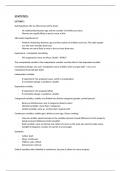Resumen
Summary with everything for midterm Statistics PM CIS
- Grado
- Institución
Summary with everything you need to learn for the midterm Statistics for Pre-master Communication & Information Sciences (Tilburg University). Including notes of the lectures, information from Practical Units, notes for Reporting results and a summary of the chapters from the book.
[Mostrar más]



